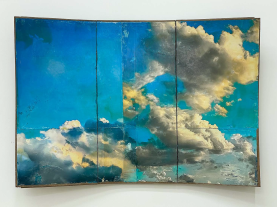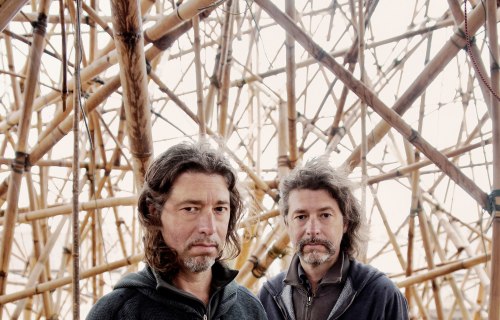
Mike and Doug Starn
Monitor: Feed your head, 2019
Acrylic paint, vintage album covers with LP's, magnets, steel frame
224 x 318.40 cm / 88 x 123 in
Mike and Doug Starn
Ravenna: Ninety miles and hour, girl, 2019
Acrylic paint, vintage album covers with LP's, magnets, steel frame
31.50 x 62.50 cm / 12 x 24 in
Mike & Doug Starn
Untitled: But the Rainbow Has a Beard, 2019
Acrylic Paint, Vintage Album Covers with LP's, Magnets, Steel Frame
224 x 158 cm / 88 x 62 in
Mike & Doug Starn
Structure of Thoughts #8, 2001 - 2004
Mis And Lysonic Inkjet Prints On Thai Mulberry, Gampi And Tissue Papers With Wax, Encaustic And Varnish
52 x 45 cm / 20 x 17 in
Edition of 5
Mike & Doug Starn
Attracted To Light 4, 1996
Toned Silver Print on Thai Mulberry Paper
51 x 51 cm / 20 x 20 in
Edition of 10

Mike & Doug Starn, photo Thomas Canet
Since the 1980s, Mike and Doug Starn’s conceptual approach to photography and use of unorthodox techniques have challenged ideas of what constitutes a photograph. The identical twin brothers came to international attention through their inclusion in the 1987 Whitney Biennial in New York. In their signature manipulation of material and form, the Starns apply innovative printing techniques and a vast array of media including transparency film, plexiglass, layered fused glass panels, gilded coloured carbon prints, scotch tape, wax and pushpins to create intense metaphorical landscapes. With the theme of light as a central component of their work, the brothers explore the physical and philosophical interconnections between subjects such as leaves, trees, snowflakes, and religious icons, with human memory, perception and thought. Working collaboratively in photography since the age of thirteen, their innovative techniques, and unique combination of sculpture, painting, and video, have defied categorisation, and earned them a position of eminence within the history of art.
Born in New Jersey, USA in 1961, Mike and Doug Starn attended The School of The Museum of Fine Arts in Boston. They have received two National Endowment for the Arts Grants (1987, 1995), The International Center for Photography’s Infinity Award for Fine Art Photography (1992), and were artists in residency at NASA in the mid-nineties. The Starns’ work has been widely exhibited worldwide. Their acclaimed monumental multimedia installation Big Bambú - comprising a perpetually evolving habitable construction of 2,000 bamboo poles - has been shown at the Metropolitan Museum of Art, New York (2010), the 54th Venice Biennale (2011), the Naoshima Museum Setouchi Triennial, Japan (2013-16), the Israel Museum, Jerusalem (2014) and the Museum of Fine Arts, Houston (2018), among others.

This Thing Called Life
